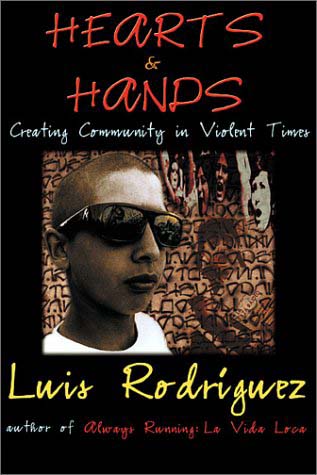|
| |
Could Today's Gangbangers Be Tomorrow's Heroes? by Luis Rodriguez
Just like the Irish, impoverished can make it with help.
By Luis J. Rodriguez

Luis J. Rodriguez is the author of "Hearts and Hands: Creating Community in Violent Times"(Seven Stories Press, 2002).
Los Angeles Times - December 19 2002
"America was born in the streets." That's what an ad says about "Gangs of New York," a film scheduled for release this week. I can't comment on the film, but I will say something about those gangs: They were some of the most brutal thieves and murderers this country has ever known.
Read Herbert Asbury's book of the same name. It's not fiction, although Asbury was known to sensationalize. The facts speak for themselves: Some of the worst gang riots in U.S. history occurred in the late 1850s and early 1860s in the tenement slums of lower Manhattan. The weeklong Dead Rabbits Riot of 1857 pitted a mostly Irish immigrant gang against the so-called Bowery Boys, resulting in more than 100 casualties, a dozen killed. The 1863 Draft Riots, also centered in the Irish immigrant community and its gangs, overshadowed that when 1,000 to 2,000 died.
Many leaders, organizers and writers found something redeeming in these "angels with dirty faces," and rightfully so. By the beginning of the 20th century, these gangs had pretty much disappeared.
How did this happen? This is something we should explore, particularly in the wake of L.A. Police Chief William Bratton's announcement of a "war" against L.A. gangs.
For one thing, massive efforts were directed at the root of Irish and other European immigrant poverty and second-class citizenry. The end of the 19th century saw the first settlement houses in cities like Chicago and New York. Chicago social activist Jane Addams helped create the first juvenile court system to alleviate the terrible conditions under which impoverished immigrant youth were held in squalid adult prisons. The police became better organized, but the real force for change was the social and political resources brought to bear, leading to the empowerment, participation and obtaining of social status for many immigrants.
In a generation or two, many of them were running cities, police forces and courts. As the most famous lawyer of the time, Clarence Darrow, once stated: "It's easy to see how to do away with what we call crime. It can be done by giving the people a chance to live."
Yet today, when gang violence has become widespread and technologically advanced, politicians and much of the media continue to bank on what hasn't worked in more than 100 years: more police and more prisons.
Very little is being done about the growing poverty in L.A. County. Moreover, we're seeing the dismantling of what social safety nets once existed and the slashing of educational and vocational opportunities where they're most needed.
If you don't give people a chance to live, you will have more crime.
Sure, we'll get increased police presence, curfew laws or graffiti abatement strategies, but what about meaningful work and skills development? What about the need for mentors, teachers and elders? What about community-based activities? What about art, principled relationships and living out one's calling?
In other words, what about doing all that's possible so children and teens can live full and complete lives?
In drug and alcohol recovery programs, insanity is defined as doing the same thing over and over again while expecting a different result. Though many young people are caught up in the madness, many of the adults who can do something about this appear insane in their response. An improved police force may help lower the crime rate briefly, but if the root causes aren't addressed, these rates will rise again -- guaranteed.
It's important to look beyond ourselves and immediate results. It's a revolutionary thing to imagine beyond our own lives.
You want to stop gangs? Find out what's vital in the lives of young people and their communities. Help provide them the necessary regenerative ground, tools and doorways. Many of us are tired of the headline-grabbing "wars" -- the War on Poverty, the War on Drugs and countless wars on gangs. In the end, we've only seen more poverty, more drugs and more gangs.
Let's declare peace and teach respect. Let's create a lasting basis for trust and eradicate the conditions that have given rise to gangs from time immemorial: poverty, abuse, fractured relationships and social neglect.
I do believe a good part of this nation was born in the streets; its future is being born there every day. If we're going to make heroes of earlier people who did all they could to survive, don't make demons of those trying to do the same thing today.
Luis Rodriguez is a co-founder of Rock A Mole Productions (www.rockamole.com). In late February, Rock A Mole (rhymes with guacamole) will stage its ninth grassroots cultural festival in Los Angeles. As always, it will feature the music, film, art, and poetry that is by or about at risk youth, immigrants, the homeless, welfare recipients, and the homeless. If you or anyone you know would like to participate, please contact Rock A Mole at rockrap@aol.com
Luis is also a co-owner of Tia Chucha's Cafe Cutlural in Sylmar in the northeast San Fernando Valley. Tia Chucha's is a cultural center (bookstore/art gallery/performance space) dedicated not only to serving the northeast Valley but to making connections all across Southern California. Check it out.
Tia Chucha's Cafe Cultural
12737 Glenoaks Blvd
Sylmar, California
818-362-7060
www.luisjrodriguez.com
www.tiachucha.com
Wednesday through Friday 4-10 PM
Saturday 3-11 PM
Sunday 2-8 PM
|
|
|
|




